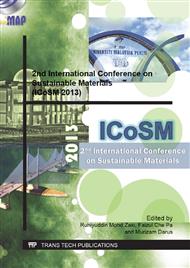[1]
A. Heilig, N. Bârsan,U.Weimar,M. Schweizer-Berberich, J.W. Gardner,W. Göpel, Fast gas sensors based on metal oxides which are stable at high temperatures, Sens. Actuators B 43 (1997) 1–10.
DOI: 10.1016/s0925-4005(97)00096-8
Google Scholar
[2]
P.W. Park, H.H. Kung, D.W. Kim, M.C. Kung, Characterization of SnO2/Al2O3 lean NOx catalysts, J. Catal. 184 (1999) 440–454.
DOI: 10.1006/jcat.1999.2459
Google Scholar
[3]
T. Minami, Transparent conducting oxide semiconductors for transparent electrodes, Semicond. Sci. Technol. 20 (2005) S35–S44.
DOI: 10.1088/0268-1242/20/4/004
Google Scholar
[4]
S.J. Han, B.C. Jang, T. Kim, S.M. Oh, T. Hyeon, Simple synthesis of hollow tin dioxide microspheres and their application to lithium-ion battery anodes, Adv. Funct. Mater. 15 (2005) 1845–1850.
DOI: 10.1002/adfm.200500243
Google Scholar
[5]
Y.L. Wang, X.C. Jiang, Y.N. Xia, Solution-phase, precursor route to polycrystalline SnO2 nanowires that can be used for gas sensing under ambient conditions, J. Am. Chem. Soc. 125 (2003) 16176–16177.
DOI: 10.1021/ja037743f
Google Scholar
[6]
A. Kolmakov, Y.X. Zhang, G.S. Cheng, M. Moskovits, Detection of COandO2 using tin oxide nanowire sensors, Adv. Mater. 15 (2003) 997–1000.
DOI: 10.1002/adma.200304889
Google Scholar
[7]
Q. Kuang, C.S. Lao, Z.L. Wang, Z.X. Xie, L.S. Zhang, High-sensitivity humidity sensor based single SnO2 nanowire, J.AmChem. Soc 129 (2007) 6070–6071.
DOI: 10.1021/ja070788m
Google Scholar
[8]
J. Huang, N. Matsunaga, K. Shimanoe, N. Yamazoe, T. Kunitake, Nanotubular SnO2 templated by cellulose fibers: synthesis and gas sensing, Chem. Mater. 17 (2005) 3513–3518.
DOI: 10.1021/cm047819m
Google Scholar
[9]
Y. Liu, M.L. Liu, Growth of aligned square-shaped SnO2 tube arrays, Adv. Funct. Mater. 15 (2005) 57–62.
DOI: 10.1002/adfm.200400001
Google Scholar
[10]
J.Q. Sun, J.S. Wang, X.C. Wu, G.S. Zhang, J.Y. Wei, S.Q. Zhang, H. Li, D.R. Chen, Novel method for high-yield synthesis of rutile SnO2 nanorods by oriented aggregation, Cryst. Growth Des. 6 (2006) 1584–1587.
DOI: 10.1021/cg050574l
Google Scholar
[11]
T.Hyodo, K. Sasahara, Y. Shimizu, M. Egashira, Preparation of macroporous SnO2 films using PMMA microspheres and their sensing properties to NOx and H2, Sens. Actuators B 106 (2005) 580–590.
DOI: 10.1016/j.snb.2004.07.024
Google Scholar
[12]
T. Hyodo, N. Nishida, Y. Shimizu, Y. Egishara, Preparation and gas-sensing properties of thermally stable mesoporous SnO2, Sens. Actuators B 83 (2002) 209–215.
DOI: 10.1016/s0925-4005(01)01042-5
Google Scholar
[13]
M. K. Kennedy, F. E. Kruis, H. Fissan, H. Nienhaus, A. Lorke, T. H. Metzger, Effect of in-flight annealing and deposition method on gas-sensitive SnOx films made from size-selected nanoparticles, Sensors and Actuators B 108 (2005) 62-69.
DOI: 10.1016/j.snb.2005.01.054
Google Scholar
[14]
K.S. Yoo, N.M. Cho, H.S. Song, H.J. Jung, Surface morphology and gas-sensing characteristics of SnO2−x thin films oxidized from Sn films, Sens. Actuators B25 (1995) 474–477.
DOI: 10.1016/0925-4005(95)85101-1
Google Scholar
[15]
A. Tsukazaki, A. Ohtomo, T. Onuma, M. Ohtani, T. Makino, M. Sumiya, K. Ohtani, S. F. Chichibu, S. Fuke, Y. Segawa, H. Ohno, H. Koinuma, and M. Kawasaki, "Repeated Temperature Modulation Epitaxy for p-Type Doping and Light-Emitting Diode Based on ZnO," Nat. Mater., 4 [1] 42–6 (2005).
DOI: 10.1038/nmat1284
Google Scholar
[16]
M. D. Irwin, D. B. Buchholz, A. W. Hains, R. P. H. Chang, and T. J. Marks, "P-Type Semiconducting Nickel Oxide as an Efficiency-Enhancing Anode Interfacial Layer in Polymer Bulk-Heterojunction Solar Cells," Proc. Natl. Acad. Sci., 105 [8] 2783–7 (2008).
DOI: 10.1073/pnas.0711990105
Google Scholar
[17]
L. Y. Liang, Z. M. Liu, H. T. Cao, X. Q. Pan, Microstructural, optical, and electrical properties of SnO thin films prepared on quartz via a two-step method, Appl. Mater. Interfaces, 2 (2010) 1060-1065.
DOI: 10.1021/am900838z
Google Scholar
[18]
Y. Ogo, H. Hiramatsu, K. Nomura, H. Yanagi, T. Kamiya, M. Hirano, and H. Hosono, "P-Channel Thin-Film Transistor Using p-Type Oxide Semiconductor, SnO," Appl. Phys. Lett., 93 [3] 032113 (2008).
DOI: 10.1063/1.2964197
Google Scholar
[19]
L.S. Chuah, M. S. Yaacob, Z. Hassan, Low temperature synthesis of Ni-doped SnO2 thin films by spin coating route, Optoelectronics and Advanceed Materials-Rapid Communications, vol. 6, no. 1-2, 157-161 (2012).
Google Scholar
[20]
L.S. Chuah, M. A. Ahmad, Z. Hassan, S. K. Mohd Bakhori, M. J. Abdullah, Nanocrystalline ZnO film grown on porous SnO2/Si(111) substrate, Composite Interfaces, vol. 18, 627-632 (2011).
DOI: 10.1163/156855411x612285
Google Scholar
[21]
L. Karen Herrera, A. Justo, J. L. Perez-Rodriquez, study of nanocrystalline SnO2 particles formed during the corrosion processes of ancient amalgam mirrors, Journal of Nano Research, vol. 8. (2009) 99-107.
DOI: 10.4028/www.scientific.net/jnanor.8.99
Google Scholar
[22]
B. Cheng, J. M. Russell, W. S. Shi, L. Zhang, E.T.J. Samulski, J. Am. Chem. Soc., 126, 5972 (2004).
Google Scholar


